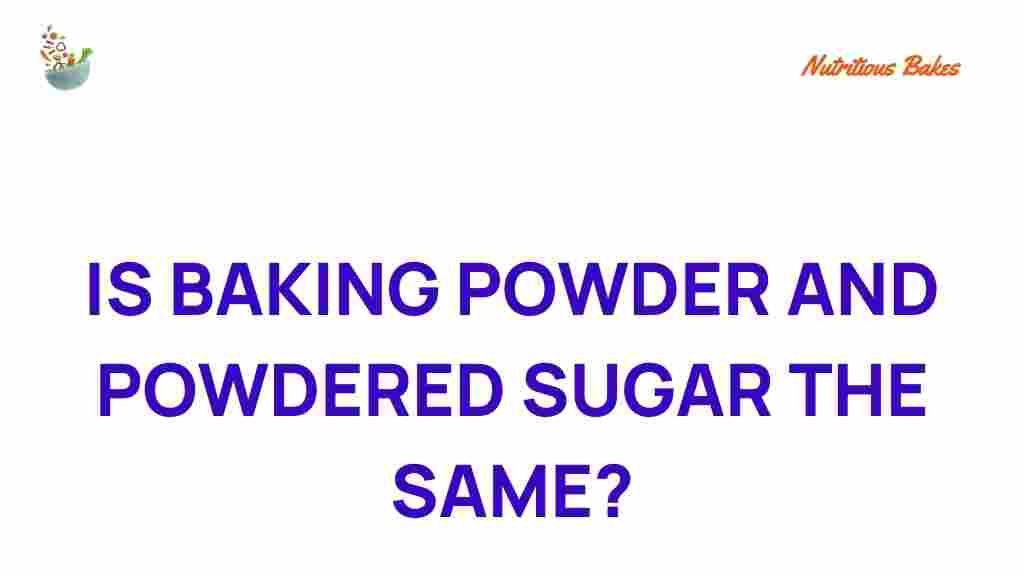Unraveling the Mystery: Are Baking Powder and Powdered Sugar the Same?
When diving into the world of baking, it’s essential to understand the ingredients you’re using. Among the many components that play a crucial role in baking, **baking powder** and **powdered sugar** are two that often cause confusion. Are they interchangeable? Do they serve the same purpose? In this article, we’ll explore the differences, uses, and characteristics of these two kitchen staples, providing you with culinary tips and baking science insights to enhance your recipes.
Understanding Baking Powder
Baking powder is a **leavening agent** used in baking to help baked goods rise. It contains a combination of an acid (usually cream of tartar) and a base (typically baking soda), along with a moisture-absorbing agent like starch. When combined with liquid and exposed to heat, it produces carbon dioxide gas, which causes doughs and batters to expand and rise.
- Types of Baking Powder:
- Single-acting baking powder: Reacts with moisture and should be baked immediately after mixing.
- Double-acting baking powder: Contains two acids and provides a two-step rise, first at room temperature and then again when heated.
The Role of Powdered Sugar
Powdered sugar, also known as confectioners’ sugar or icing sugar, is a finely ground sugar mixed with a small amount of anti-caking agent like cornstarch. Its texture is incredibly fine, making it ideal for creating smooth icings, frostings, and dusting over desserts.
- Uses of Powdered Sugar:
- Making frostings and glazes for cakes.
- Dusting over pastries for decoration.
- Sweetening whipped cream or mousses.
Key Differences Between Baking Powder and Powdered Sugar
While **baking powder** and **powdered sugar** are both essential baking ingredients, they serve vastly different purposes. Here are the primary distinctions:
- Function: Baking powder acts as a leavening agent, while powdered sugar is a sweetener.
- Composition: Baking powder comprises acids and bases, whereas powdered sugar is simply finely ground sugar.
- Texture: Baking powder has a gritty texture, while powdered sugar is extremely fine and fluffy.
When to Use Baking Powder
Using baking powder is crucial in many recipes, especially those that need to rise. Here are some culinary tips on when to incorporate baking powder:
- In recipes for cakes, muffins, and quick breads.
- When the recipe includes acidic ingredients like yogurt or buttermilk, which activate the leavening properties.
When to Use Powdered Sugar
Powdered sugar is best used in recipes that require a smooth texture and sweetness without the graininess of granulated sugar. Here are some applications:
- For making buttercream frosting.
- In recipes for delicate desserts like panna cotta or mousse.
Common Baking Recipes: Using Baking Powder and Powdered Sugar
To illustrate the roles of these ingredients, let’s look at a couple of popular baking recipes:
Classic Vanilla Cupcakes
These fluffy cupcakes rely on baking powder for their rise. Here’s a simple recipe:
- Ingredients:
- 1 ½ cups all-purpose flour
- 1 cup sugar
- ½ cup unsalted butter, softened
- 2 eggs
- 1 ½ teaspoons baking powder
- ½ cup milk
- 1 teaspoon vanilla extract
Instructions:
- Preheat your oven to 350°F (175°C).
- In a bowl, cream the butter and sugar until light and fluffy.
- Add eggs one at a time, mixing well after each addition.
- In a separate bowl, combine flour and baking powder, then gradually add to the butter mixture, alternating with milk.
- Mix in vanilla extract.
- Pour the batter into cupcake liners and bake for 20-25 minutes.
Simple Royal Icing
This icing, perfect for decorating cookies, features powdered sugar:
- Ingredients:
- 2 cups powdered sugar
- 1 egg white (or 2 tablespoons meringue powder)
- 1 teaspoon lemon juice
Instructions:
- In a mixing bowl, combine powdered sugar and egg white (or meringue powder).
- Add lemon juice and mix until you achieve a smooth consistency.
- Adjust the consistency by adding more powdered sugar or a few drops of water as needed.
Substitutions and Troubleshooting Tips
Sometimes, you may find yourself short on either baking powder or powdered sugar. Here are some substitutes:
- For Baking Powder: You can create a homemade version by mixing 1 part baking soda with 2 parts cream of tartar.
- For Powdered Sugar: Blend granulated sugar in a blender or food processor until finely ground. Add a teaspoon of cornstarch per cup to prevent clumping.
Here are some troubleshooting tips for common baking issues:
- If your cake is dense, you may have used too little baking powder or not mixed the batter enough.
- If your frosting is grainy, ensure you’ve used finely ground powdered sugar and mixed it well to dissolve any lumps.
Baking Science: The Chemistry Behind It
The science of baking is fascinating, as it involves a complex interaction of ingredients. Understanding the role of **baking powder** and **powdered sugar** can help you master your baking skills:
- Leavening Action: Baking powder releases gas when moistened and heated, causing doughs to rise. This is a critical reaction in baking science.
- Texture and Consistency: Powdered sugar’s fine texture allows it to dissolve quickly, making it perfect for smooth icings and toppings.
Conclusion
In conclusion, **baking powder** and **powdered sugar** are not the same; each serves a unique purpose in the realm of baking. Understanding their roles can elevate your baking game, allowing you to create delicious treats with the right texture and flavor. By mastering these culinary tips and the science behind baking, you’ll be equipped to handle various recipes and baking challenges with confidence.
For more baking tips and recipes, check out this helpful resource that dives deeper into the world of baking ingredients. Happy baking!
This article is in the category Ingredients and created by NutritiousBakes Team
